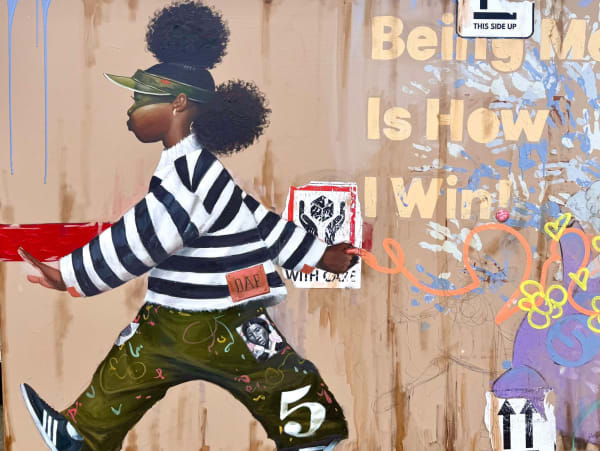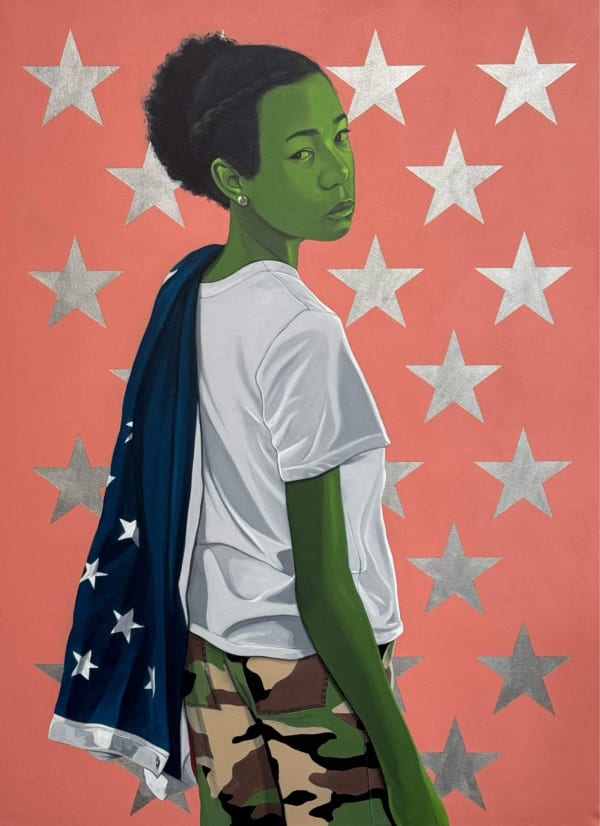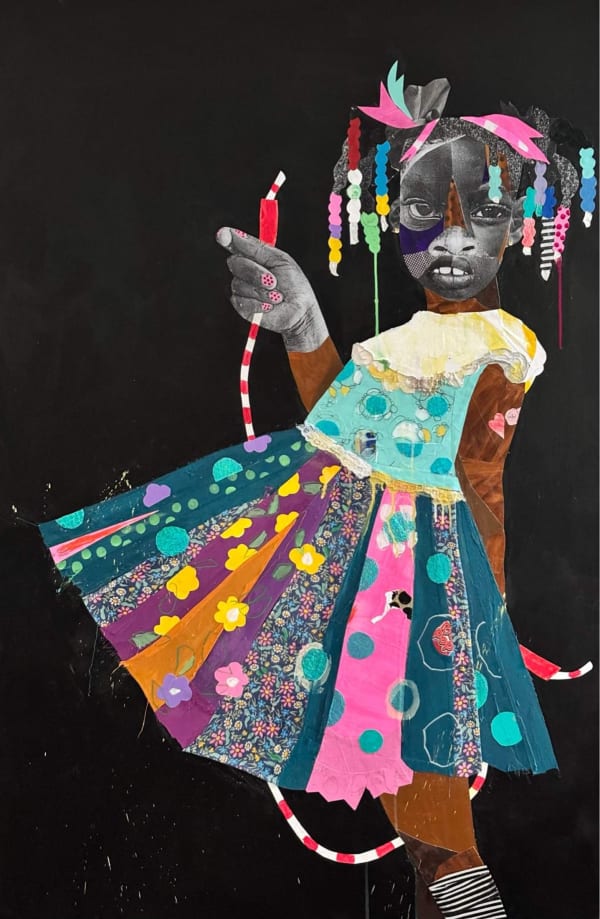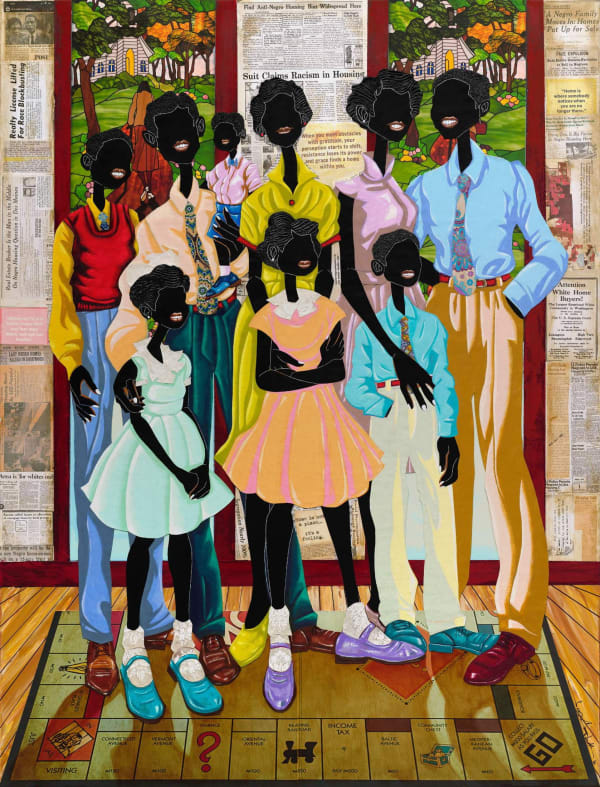What if reality is not what we believe it to be but a construct—a simulation—designed to limit our imagination, confine our aspirations, and perpetuate cycles of control? Break the Simulation invites viewers to interrogate the nature of the "real" and consider the systems that dictate our perceptions, particularly for Black individuals whose lives are often framed by inherited narratives and restrictive societal roles. Featuring six visionary artists, the exhibition dissects the architecture of this simulation through deeply personal stories that illuminate the profound effects of systemic constraints, internalized beliefs, and cultural conditioning. Each artist offers a lens into the ways we can see beyond the illusion and rediscover our agency, imagination, and fearlessness in shaping a more liberated existence.
Internalized oppression is one of the most insidious aspects of the simulation. It is the absorption of societal limitations, the silent acceptance of roles designed to suppress individuality, creativity, and ultimately unique identities. For Black individuals, this often takes the form of cultural conditioning that prioritizes survival over imagination, adherence over rebellion. These are concepts explored by Frantz Fanon’s Black Skin, White Masks, which frames this as a psychological legacy of colonialism, where imposed cultural inferiority becomes internalized, alienating individuals from their true identities.
The exhibition challenges these limiting beliefs, inviting viewers to confront the "scripts" we didn’t write but often live by. In James Baldwin’s The Fire Next Time, he critiques the confines of African Americans we recognize today as results of the legacy of historical oppression and societal expectations that encourage us to redefine identity as more than these societal scripts with which we have become complacent. The notions resonate with the metaphor of the "coffee table," symbolizing childhood rules that restrict curiosity and selfexpression. The works collectively serve as a mirror, forcing viewers to question the invisible forces shaping their realities and the narratives they unconsciously uphold.
To break the simulation, one must be fearless—bold enough to question reality, to disrupt the comfort of conformity, and to rebel against oppressive norms. Fearlessness requires rejecting the conditioning that tells us to play small, avoid risk, and stay within the boundaries set for us. For Black individuals, this rebellion is not just a personal act but a radical declaration of liberation against systems that have historically demanded obedience.
Drawing inspiration from René Descartes’ Meditations on First Philosophy, which posits that reality may be a construct of a deceiving force, the works here disrupt traditional understandings of what it means to rebel, presenting rebellion not as chaos but as a reimagining of possibility. This rebellion is not without risk, but it is essential to achieving liberation. The artists' works collectively demonstrate the necessity of rejecting the past’s hold and embracing an unapologetic boldness to envision new realities.
The simulation begins early, often in childhood when society’s expectations shape the lens through which we view the world. Plato’s Allegory of the Cave provides a striking parallel— children, like the cave’s prisoners, are taught to accept shadows as reality, their imaginations constrained by what they are allowed to see and believe. For Black children, these constraints are especially potent, compounded by the legacy of systemic racism that stifles creativity and enforces conformity.
Much like the discussion by bell hooks in Ain’t I a Woman: Black Women and Feminism, the societal systems “brainwash” the diverse identities of the Black community with deeply internalized oppressive narratives. The works poignantly examine how early conditioning shapes not only identity but also the capacity to imagine and create freely. The exhibition is a call to unlearn, to return to the boundless creativity of childhood before it was conditioned out of us. It reminds viewers of the power of imagination as a tool for liberation.
Breaking the simulation is an act of defiance, but it is also an act of creation. To break free is to reject the inherited scripts of internalized oppression, fear, and conformity and to reclaim the power to imagine and shape one’s reality. It is time to question the nature of reality and embrace agency in reshaping it. In rejecting internalized racism, social constraints, and stereotypes that psychologically condition African Americans we can combat the inherent systems that shape the perceptions that inevitably limit their potential. The exhibition achieves this by challenging their perceptions and encouraging active reflection with each artist contributing their own narratives, weaving a collective story of resistance and possibility.
Break the Simulation is not merely an exhibition but an experience. The transformative impact is twofold: to provoke deep introspection and to inspire bold action. Viewers are encouraged to confront the scripts they live by and to question whose interests those scripts serve. The exhibition seeks to be both a mirror and a beacon—a space to see oneself reflected in stories of struggle and triumph and to find inspiration for breaking free from the constraints of the simulation. Ultimately, amplifying a sense of collective empowerment, all who enter are reminded that liberation begins with the courage to imagine a different reality.











